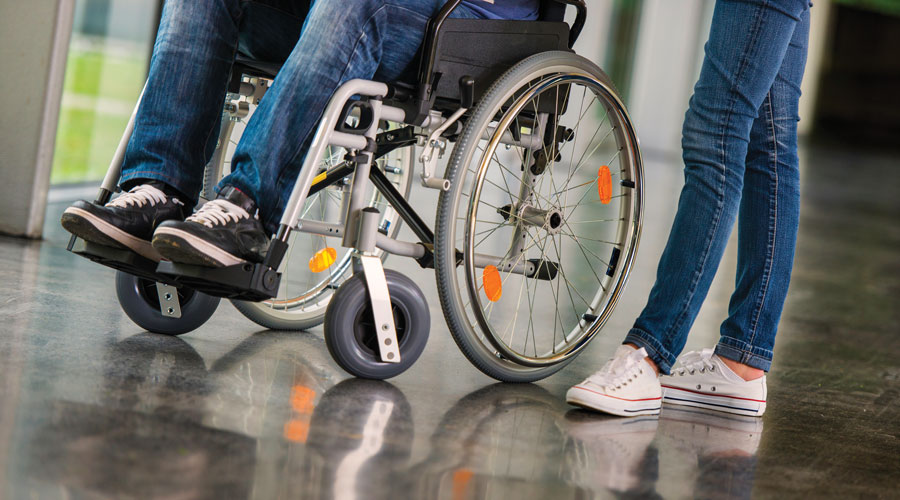Now’s the time to make sure your pharmacy is not only complying with disability regulations, but also going above and beyond to serve a key portion of your patients.
This year marks the 25th anniversary of the Americans with Disabilities Act (ADA), which was signed into law in 1990 and made unprecedented improvements to the quality of life for millions of Americans living with disabilities.
“For the past 25 years, the ADA has made a positive difference in the lives of those who have disabilities by ensuring better access to buildings, transportation, and employment,” Georgina Peacock, M.D., M.P.H., director of the Centers for Disease Control and Prevention’s Division of Human Development and Disability, said in a July 2015 press release.
Today, individuals with disabilities account for 18 percent of the U.S. population, making this group the largest minority in the U.S. And, the number of individuals who live with a disability will continue to grow as the baby boomer generation ages.
As an independent community pharmacy owner, manager or pharmacist, you don’t want to unintentionally exclude a large portion of your community from using your services—and consequently losing business.
While it’s your responsibility to comply with the requirements established by the ADA, you can take steps beyond your legal obligations to create a comfortable environment for individuals of all ability levels in your pharmacy. Complying with these recommendations can create a more inclusive pharmacy, while also helping you gain new, loyal patients.
Keys for ADA compliancy
The ADA states that, “no qualified individual with a disability shall, by reason of such disability, be excluded from participation in or be denied the benefits of services, programs, or activities of a public entity, or be subjected to discrimination by any such entity.”
As a business, your pharmacy is required to make “reasonable modifications” in both policy and procedure to accommodate those with disabilities, so they can use your store and services.
From the entryway to the front end to the pharmacy counter, here are some key ADA requirements to meet— and exceed—to create a pharmacy that individuals of all abilities will want to give their business to.
Parking and entrance
The number of accessible parking spaces your pharmacy is required to provide depends on the size of your parking lot. If your pharmacy has 26 to 50 spaces, you’re required to have at least two accessible spots, and at least one for parking lots with one to 25 spaces. If you have a small lot of four or fewer spaces, you still need to have one accessible parking spot, but there’s no accessible parking signage required.
So, what makes a parking space “accessible”? Accessible spaces must have an access aisle, which allows a person using a wheelchair to get in and out of his or her vehicle.
Even just one step outside your entrance could prevent potential patients who use mobility devices from entering your business. Installing a ramp, lift or railing along the walkway can provide accessibility. Or, you could create a second entrance if the main entrance isn’t accessible. If you have multiple entrances to your pharmacy, you’re required to post signage to indicate which entrances are accessible.
Aisles, shelving and counters
The path a patient who uses a wheelchair or mobility device takes through your pharmacy is known as an “accessible route,” and must be at least three feet wide.
The accessible route can only be blocked for temporary interruptions, such as restocking your shelves. During this time, you or a staff member must be available to assist the patient in retrieving items from the blocked area.
The ADA does not restrict the height of shelves or selling space, but keep those who use mobility devices in mind when arranging and stocking your front-end shelves.
Make sure an employee is available to help patients locate and reach items that are too high or too low.
Accessible communications
Because disabilities are unique to every person, flexible communication skills are essential for positive interactions with your patients with disabilities.
“In order to provide equal access, a public accommodation is required to make available appropriate auxiliary aids and services where necessary to ensure effective communication,” according to the ADA. “The type of auxiliary aid or service necessary to ensure effective communication will vary in accordance with the length and complexity of the communication involved.”
Systems your pharmacy already has in place, such as text message refill reminders, may eliminate some challenges for individuals who are deaf or hearing impaired. And, many patients with vision impairment use read-aloud apps for their smartphones.
Still, you and your employees need to be prepared to accept phone calls from a Text Telephone (TTY), which individuals with a hearing or speech impairment may choose to use.
Writing notes with someone who is deaf or hearing impaired may do the trick for simple transactions, but complex medical conversations may require the use of an interpreter.
If you’re using an interpreter in-person, as opposed to remote video interpretation, make sure to speak to the individual—not the interpreter—and make eye contact with her as she signs back to you.
If you live in an area with a large deaf population, consider hiring a staff member who speaks American Sign Language (ASL).
Even if you only have one or two patients who are hearing impaired or deaf, try learning a few simple greetings or questions in ASL. Just as you learn facts about individual patients’ lives, like the names of their children or where they work, learning a few greetings in ASL can show that you take a personal interest in your patients.
Also, be prepared to help individuals who are visually impaired or blind find products and read labels. It may also benefit individuals with an intellectual disability to hear labels read aloud or to receive additional explanation of instructions.
You can also make your informational pamphlets and other materials more accessible by offering them in large-print versions for the visually impaired.
Improving interactions
It’s important for all employees at your pharmacy to know how to speak to patients about their disability. The ADA Update: A Primer for Small Business provides helpful outlines for speaking with patients about their disability. Consider adding it to your employee training materials.
Perhaps an individual enters your store, and you are doubtful that he really depends on his assistive device. According to the guide, it’s not permissible to ask individuals about their disabilities, unless you’re discussing their needs pertaining to their medication or medical supplies.
A situation could arise, however, when you must tactfully inquire about an individual’s disability.
For example, if an individual enters your pharmacy with a presumed service animal, you may only ask two questions: “Is the animal required because of a disability?” and “What work or task has the animal been trained to perform?”
Another situation where the need to explicitly discuss a patient’s disability is if she is using a powered device for transportation that’s not intended for disability assistance, such as a motorized scooter or segway. “Public accommodations must allow individuals who use these devices to enter the premises unless the business can demonstrate that the particular type of device cannot be accommodated because of legitimate safety concerns,” according to the guide.
If a situation arises when you may question the use of a piece of assistive-equipment, remember to remain patient and respectful at all times, as not all disabilities are visible.
To view a comprehensive guide on all of the requirements for ADA-compliance, visit the ADA website, or the small business guide for ADA regulations.
By the numbers
13 percent of adults have impaired mobility
10.6 percent of adults have impaired cognition
6.5 percent of adults have independent living challenges
4.6 percent of adults are blind or visually impaired
3.6 percent of adults have difficulty with self-care
Disabilities and health
Your patients with disabilities are potentially at risk for other health ailments. Here’s a look at it by the numbers.
With disabilities
Obesity 38.4%
Smoking 30.3%
High blood pressure 41.7%
Inactivity 36.3%
Without disabilities
Obesity 24.4%
Smoking 16.7%
High blood pressure 26.3%
Inactivity 23.9%
Source: Centers for Disease Control and Prevention, Disability Impacts All of Us infographic












